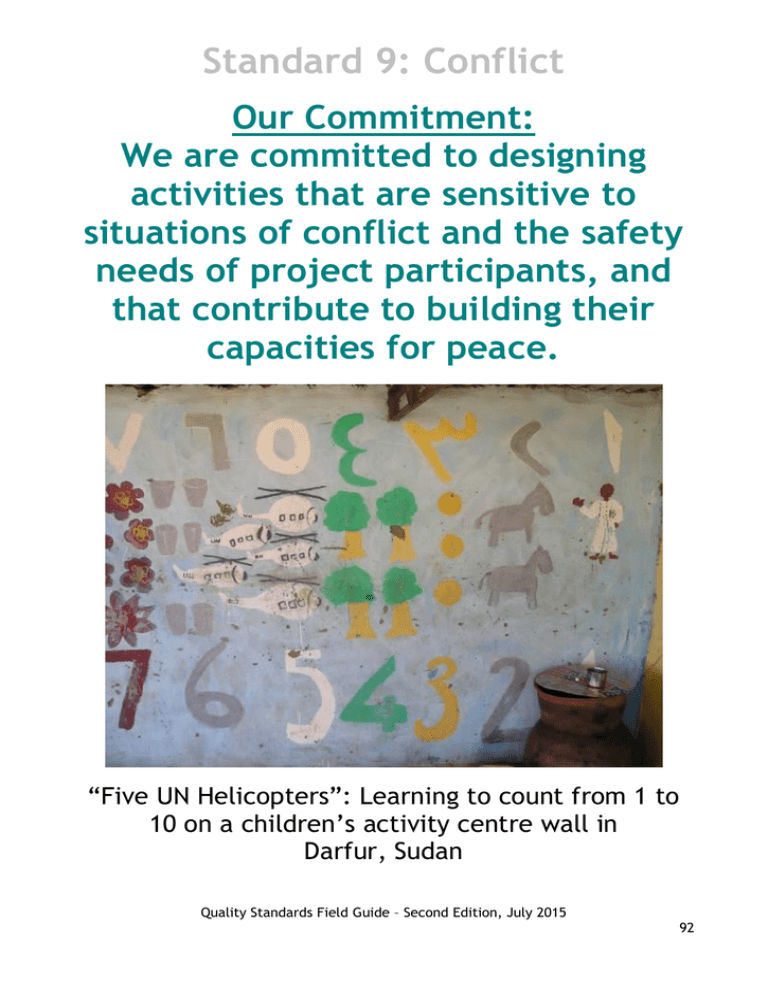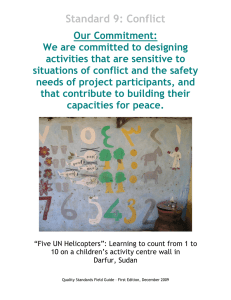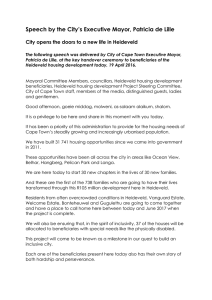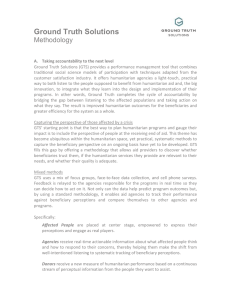Standard 9: Conflict
advertisement

Standard 9: Conflict Our Commitment: We are committed to designing activities that are sensitive to situations of conflict and the safety needs of project participants, and that contribute to building their capacities for peace. “Five UN Helicopters”: Learning to count from 1 to 10 on a children’s activity centre wall in Darfur, Sudan Quality Standards Field Guide – Second Edition, July 2015 92 Standard 9: Conflict The issues Conflict is a major development issue: poverty and injustice can feed the anger which leads to conflict, and this conflict can then deepen poverty and increase injustice. Violent conflict entails the loss of civilian life, social and economic disruption, displacement, and destruction of the environment and of infrastructure. There are on-going effects even after a conflict ends: a legacy of democracy and human rights abuses, landmines, surplus small arms, amputees, orphans, children who have missed out on education and communities who have been left mentally scarred by witnessing or taking part in atrocities. Conflict is also a major factor for providers of humanitarian relief, as it not only creates the situations that see individuals in need of emergency humanitarian assistance, but also restricts access to those in need, and prevents communities from using traditional coping mechanisms. Conflict destabilises government and political systems that would usually provide services for the population, adding to distrust and fear between communities and contributing to the physical, psychological or emotional harm of the population. Many of the world’s poor people live in countries affected by conflict. Violent conflict destroys hard-won relief and development gains, prevents progress towards the Millennium Development Goals and hinders economic growth. Of the 34 poor countries farthest from reaching the Millennium Development Goals, 22 are in or are emerging from violent conflict.3 Biblical foundations Tearfund’s response to conflict4 is guided by key biblical principles, namely, that: Injustice, broken relationships and violence are the result of human sin, and the victims of conflict often suffer because of the sin of others Violence cannot advance the kingdom of God Those with power have a duty to defend the victims of injustice, and to oppose and seek justice towards the perpetrators. Amongst the Beatitudes, we read that “blessed are the peace-makers, for they shall be called sons of God” (Matt.5:9). Christians are called to bring peace, forgiveness and reconciliation, based upon God’s forgiveness of us in Christ. Good Practice Commitments Just as violent conflict sets back development, we will also find that poorly planned development or insensitive emergency response can worsen conflict. Aid 3 Investing in Development: A Practical Plan to Achieve the Millennium Development Goals, UN Millennium Project, 2005 4 Tearfund Framework policy on conflict. March 2005. Quality Standards Field Guide – Second Edition, July 2015 93 Standard 9: Conflict influences the political and economic dynamics of conflict. It can, for example, introduce resources that alter power relationships in ways that fuel local tensions. At worst, programmes that do not consider the conflict situation in which they work can increase the vulnerability of beneficiaries to violent attack or heighten the intensity of the conflict itself. It is not enough to rely on development or relief aid to prevent violent conflict, because it might have the opposite effect. The potential impact of relief and development work upon a conflict must be thoroughly evaluated. We should also beware of those people who use and promote violent conflict for political and personal benefit. Close links to other Quality Standards Our commitment on conflict has close links to: Impartiality, ensuring that our impartiality is clearly understood by all parties in conflict situations; Accountability, in recognising the need for making information publicly available (e.g. the beneficiary selection criteria), facilitating participation and creating routes for giving feedback in conflict situations; Gender, recognising the vulnerability, particularly of women and girls in conflict situations; and HIV, recognising the vulnerability, particularly of women and girls to HIV in conflict situations. Where to look for further information: Tearfund Conflict management documents: http://tilz.tearfund.org/en/quality_standards/conflict/ Oxfam’s Protection Training pack: http://policypractice.oxfam.org.uk/publications/improving-the-safety-of-civilians-aprotection-training-pack-115396 ODI Humanitarian Practice Network paper on Oxfam’s approach to mainstreaming safety in humanitarian programmes http://www.odihpn.org/humanitarian-exchange-magazine/issue39/reclaiming-mainstreaming-oxfam-gbs-protection-approach-in-drc World Bank Conflict Analysis Framework: http://siteresources.worldbank.org/INTCPR/2145741112883508044/20657757/CAFApril2005.pdf Quality Standards Field Guide – Second Edition, July 2015 94 Standard 9: Conflict Conflict Sensitive development: http://www.saferworld.org.uk/what/conflict-sensitive-development Quality Standards Field Guide – Second Edition, July 2015 95 Standard 9: Conflict Practical Steps for carrying out our Conflict commitment Identification Step 1: Analyse and understand the conflict situation in order to guide your project design Step 2: Identify the appropriate level of association that the organisation should have with different actors in the conflict Design Step 3: Ensure the project design prioritizes the safety of beneficiaries when this is their primary concern Step 4: Assess the potential impact of the project’s design with the community before you commence activities Implementation Step 5: Publicise the impartiality and independence of the organisation Step 6: Seek out opportunities for building the capacity for peace Step 7: Monitor the attitudes within the community towards the organisation and adapt project plans in light of feedback received Quality Standards Field Guide – Second Edition, July 2015 96 Standard 9: Conflict Step 1: Analyse and understand the conflict situation in order to guide your project design Use conflict analysis tools with project staff and as many community members as possible and appropriate, including men, women, boys and girls. to gain a better understanding of the different parties in the area, the relationships between them and the causes of tension. Available tools include mapping, time-lines, conflict tree and ABC triangle (see TF Good Practice Guideline on Conflict Sensitivity). Gain a full understanding of the conflict context, the changing dynamics – at the local level, regional/national and the wider global context: use the analysis in security reports, look at news websites, look at IRIN or Alertnet analysis, ask the UN Resident Coordinator for the latest situation report. Repeat the analysis at regular intervals (at least twice a year) to keep the analysis up-to-date; do an extra analysis if significant people move. Stay up-to-date with political, humanitarian and security information that might help identify trends, patterns of abuse, behaviour of conflicting parties, high risk locations, anticipated increases in conflict, etc. What to analyse and why? (see also step 4) What? Identify all the groups involved in the conflict Identify where the NGO or partner organisation sits in the conflict (i.e. with whom does the NGO have links/relationships? Find out the history of the conflict, underlying grievances, seasonal patterns, current events and past experiences. Find out if the beneficiary communities have any safety needs Why? To understand who they are, their different perspectives, aims and objectives, how they relate to each other, where they get their support, and how they operate. To assess how activities and targeting could impact upon the conflict, positively or negatively. E.g. positively if competition for resources is reduced, or shared activities increased, but negatively if existing inequalities (eg in employment opportunities) are re-enforced. This serves as the basis for developing strategy and plans. The project should never worsen the situation, nor create risks for project personnel. To identify some of the long-standing root causes of the conflict (e.g. water) which project could try to address. To assist with project planning – i.e. not to do things which add to the conflict, nor to put staff at risk by doing field work in the “conflict season” To identify ways in which projects could be designed and implemented in order to improve the safety of beneficiaries. Quality Standards Field Guide – Second Edition, July 2015 97 Standard 9: Conflict Step 2:Identify the appropriate level of association that the organisation should have with different actors in the conflict NGOs have often become targets in a conflict if they have been perceived to be favouring one group over another when giving assistance, or if the level of association with one party suggests an alliance with that group. “Perception” is the critical consideration here: even if the NGO has not deliberately set out to associate themselves in this way, they may be perceived to be showing partiality to one group. The opposing group may no longer see the agency as impartial or independent, which could then endanger both staff and beneficiaries. Assess how the different power-holding groups are perceived by the beneficiary groups and the wider population. There may be several different armed forces in the area – government military, UN peacekeepers, opposition militias, etc. Local staff will have greater understanding of community feelings towards these armed groups, and their perceptions of NGOs. Ensure that close association with any one group does not cause another group to question your impartiality and independence. Develop key relationships at a number of levels – not just with community leaders, militia commanders and others, but find out who has the greatest influence. Local staff will be able to advise on levels of influence within the local community hierarchy. For local safety and day-to-day activities, it may be adequate to maintain a good relationship with local government or military leaders. The extension of activities or travel into new areas will usually require contacts and permissions from those higher up in the authority structure. Quality Standards Field Guide – Second Edition, July 2015 98 Standard 9: Conflict Step 3: Ensure the project design prioritizes the safety of beneficiaries when this is their primary concern Assess the safety needs of the community, as part of the needs assessment process. Safety from abuse may be the primary concern of the community. When this is the case, safety must be amongst the main factors guiding the design of the project. In every sector (WASH, Hygiene Promotion, Nutrition, Shelter, Food Security, etc.) activities should be designed in a way that provides safety for beneficiaries or reduces their vulnerability to violence and attack. Ensure that the project does not increase the vulnerability of beneficiaries (risk of attack, gender-based violence, bombardment, theft, jealousies, etc.) but aims instead to reduce it. Set indicators to measure the improved safety of civilian beneficiaries throughout the life of the project (e.g. number of recorded attacks). Do needs assessments and provide services early in the project to establish an understanding amongst beneficiaries, leaders and combatants of how an NGO works. A culture of accountability does not always come naturally to leaders. If they are allowed to manipulate service delivery or distributions early on it will be difficult to correct this later. Find out what agencies in your location are mandated to protect the safety of civilians. Assess the risks to beneficiaries if they participate in the project, and agree an appropriate level of association with the protecting agencies. This can be done informally in highly sensitive situations. Quality Standards Field Guide – Second Edition, July 2015 99 Standard 9: Conflict Step 4: Assess the potential impact of the project’s design with the community before you commence activities Consult with local staff and beneficiaries to understand how proposed actions will be perceived. (See also step 1, about analysing the conflict.) Consider the different activities in the log-frame and identify ways in which these could impact negatively or positively on the conflict. E.g. in selecting a site for a well, consider access for all and avoid disputed areas of land. Ensure the level of assistance provided to different groups is proportionate to their needs and can be clearly justified. Remember that excluding one community from a project may add to the insecurity of another group (i.e. retaliation for perceived partiality). If the needs are mostly found with one group, look for ways of providing some other inputs for the “excluded” group. Look for any possible “side effects” of a programme: indirect repercussions of your work that add to the conflict. Step 5: Publicise the impartiality and independence of the organisation Ensure your NGO status and commitments to NGO principles are understood by all – by beneficiaries, the wider community, and by all sides of the conflict (also refer to Standard 3: Beneficiary Accountability). The Red Cross Code of Conduct is very useful in promoting humanitarian principles. Consider use of posters and sharing booklets of the RCCC with stakeholders. If a donor agency requires high visibility (e.g. signboards, labels, etc.) and the donor’s government is seen as taking one side in the conflict, then consider the consequences carefully before accepting such funding. Provide repeated training to reinforce these messages. Ensure recruitment of local staff is balanced and cannot be interpreted as you favouring one particular group. Quality Standards Field Guide – Second Edition, July 2015 100 Standard 9: Conflict Step 6: Seek out opportunities for building the capacity for peace Ask the staff and communities what peace would look like in the local context. If possible, include some actions into your sectoral work that would move towards this peaceful state. Some people will be opposed to “peace” in any form and so direct peace-building or even use of the word may need to be avoided. Consult with beneficiaries and others to ensure that activities listed below are appropriate to your context. They are often possible when a relationship of respect and trust has been established with the community: o Introduce peace-building and reconciliation messages within project activities, such as a Health Promotion curriculum or training for a development committee o Create opportunities where issues relating to the conflict and opportunities for peace & reconciliation can be discussed o Create appropriate opportunities (only after careful planning and discussion) where people can interact peacefully with the “opposition”, such as joint activities on a community project, a health lesson, joint training for water pump mechanics, etc. o Use resources or design activities which reward peaceful behaviour and discourage those which foster hostility. o Where there are local churches, work with these churches to promote peace. The church, in many communities, can help to bring reconciliation and build peace. In complex emergencies, it can have a role in preventing future outbreaks of violence by helping people to address issues of resentment, forgiveness, exclusion and alienation. The church can enable the appropriate resolution of disputes at a local level before they escalate onto a regional level. o In both relief and development projects, the church may be able to challenge favouritism and competition over scarce resources. Justice, impartiality and forgiveness are important principles in such contexts and the church is in a position to offer these. Quality Standards Field Guide – Second Edition, July 2015 101 Standard 9: Conflict Step 7: Monitor the attitudes within the community towards the organisation and adapt project plans in light of feedback received It is good to check regularly that your impartiality and independence is still understood and accepted. This can be done with community leaders or with focus groups, asking regularly about their perception of NGO’s and satisfaction with progress of project activities. Note any significant changes and adjust the level of association with the different actors in the conflict, as needed. Use the feedback mechanism to help to do this. Check if any complaints have arisen and whether or not these have been dealt with (also refer Standard 3: Accountability for more information on feedback mechanisms). In light of the above, reinforce the messages around your impartiality and independence, and if necessary adjust your project design (beneficiary selection, assistance package, etc.) If possible, establish “indicators of instability” – i.e. attitudes or behaviour in the community that suggests that relationships are beginning to break down – e.g. the closure of local markets, or people migration, or lower attendance at a clinic or feeding centre. Quality Standards Field Guide – Second Edition, July 2015 102 Standard 9: Conflict Project Examples: In Sierra Leone, alongside water and sanitation projects which supported the resettlement process at the end of the civil war, projects also included conflict transformation training with communities. This led to some creating “peace committees”, where communities resolved to addressing their disputes without needing to go to the regional authorities (an issue which was a contributing factor behind the war). A partner carrying out relief and risk reduction projects in Marsabit, North Kenya, worked with local churches to establish peace-making forums to prevent future outbreaks of violence between two pastoral communities over grazing rights and scarce water sources. The Baptist and Presbyterian churches in Manipur’s NE India peace initiative challenged both communities on either side of a conflict to forgive the wrongs committed against each other and overcome the deep-seated anger that had gripped both sides of the conflict. The pastors challenged their communities with Christian values to stop the fighting. These churches and their pastors were ultimately the only people with sufficient authority to be able to mobilise the wider community for peace. In Zimbabwe, a partner implemented a seed, fertilizer and tools project for victims of political violence relating to the elections of 2008. Beneficiaries included people from both sides of the violence, who in many cases were neighbours. The project design included joint training sessions so that relationships could be re-established in a safe environment and even encouraged them to work together to prepare their fields. This has promoted reconciliation and healing. Quality Standards Field Guide – Second Edition, July 2015 103





